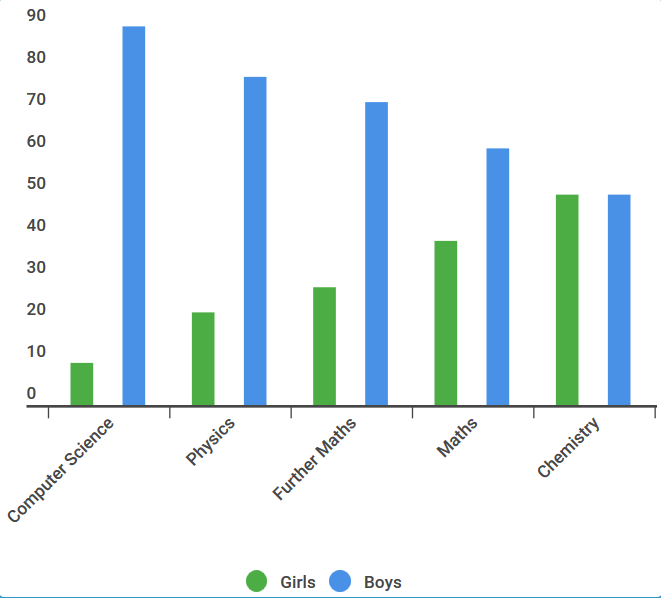Although young women tend to perform as well or better than their male peers in STEM (Science, Technology, Engineering and Mathematics) subjects, negative stereotyping can lead female students to feel insecure about their ability in science. Students’, and particularly girls’, interest in science tends to deteriorate rapidly after the age of 14, so school years are a critical time for nurturing their aspirations in STEM fields.


Percentage of girls and boys entered for STEM A Levels in 2016. Source: JCQ.
Inspiring a genuine enjoyment and appreciation of science during GCSEs will encourage female students to consider STEM subjects at A-Level, and ultimately make them more open to careers in science. In this post, we’ll discuss practical strategies which teachers can use to engage and enthuse female students while teaching science.
Create a ‘can-do’ atmosphere
Students and staff in schools with a high uptake of STEM subjects by female students are less likely to mention or perceive a difference in difficulty in STEM qualifications compared to other subjects. A ‘can-do’ attitude helps students to feel able to take on the challenge of pursuing science A Levels. In contrast, female students at lower-performing schools tend to cite difficulty as the main reason for not pursuing STEM subjects.
STEM subjects also suffer from the perception that they are ‘for boys’, and female students are deterred by the prospect of classes or even careers where their environment will be male-dominated.
Actions:
- Combat the idea that STEM subjects are fundamentally hard, and focus on their positive aspects where possible – for example, the increased employability which STEM students benefit from, or their range of applications in the real world.
- Ensure that teachers are aware of the negative effects of stereotyping on students, end ensure that male and female students are encouraged equally to pursue STEM subjects.
- Try not to use mostly male examples when talking about students or professionals in STEM disciplines.
Communicate the relevance of STEM subjects
When choosing which subjects to pursue, young women tend to place more importance on the perceived relevance of the subjects to a bigger picture or greater good, while young men prioritise the relevance of subjects to applications or career ambitions.
Although careers in research and science are essential for solving pressing, human issues such as climate change and sustainable farming, STEM disciplines are often perceived as dispassionate and impersonal by school students, which is particularly off-putting for young women.
Actions:
- Link science with the ‘big picture’ by emphasising links between different topics, and relating subject matter to key ideas and applications.
- Try to make connections between subject matter and current news stories or ‘hot topics’. For example, students could be tasked with finding news stories which link to the seemingly abstract content which they’re learning in school.
Asking questions
Science lessons tend to involve more closed questions (i.e. questions which have a brief, factual response), which can intimidate female students who are worried about giving an incorrect answer. In mixed classes, boys are overwhelmingly the first to respond to ‘hands up’ questions, which can mean that girls are left behind.
Actions:
- Enforce 30 seconds of ‘thinking time’ before students offer answers to questions. This will reduce the competitive element and create a less pressured environment.
- Give students individual whiteboards to write their answers and hold up when you ask for answers – this will reduce students’ fear of judgement and promotes equal participation in discussion.
- Allow students to discuss the question in small groups before giving their answers. This way, students who don’t feel confident enough to speak in front of the class are still given the opportunity to engage with lesson content.
Jargon and technical language
Technical language, including equations and scientific jargon, is common in STEM subjects, and can be alienating for less confident students, as students feel less able to ask questions when they can’t access the language used to discuss scientific topics. An emphasis on understanding underlying concepts and demystifying course content is key in engaging these pupils.
Actions:
- Make sure that underlying concepts are fully explained and understood before introducing equations.
- Encourage students to use technical language carefully, ensuring that it is applied correctly and within the right context.
Practical work
Observing girls and boys in science lessons reveals different approaches to practical work: while girls emphasise the importance of planning and understanding underlying concepts, boys are keener to move straight on to practical work. In mixed classes, this can lead to the polarisation of roles, with boys leading the practical work and girls taking on ‘scribe’ or note-taking roles.
Actions:
- Try assigning roles to students within practical groups, and rotating these roles each lesson. This will give all students the opportunity to learn the different skills required for scientific experimentation.


Margaret Hamilton, who pioneered the development of NASA’s Apollo 11 onboard flight software, and is credited with creating the field of software engineering.
Positive role models
Without access to positive female role models in science, it can be hard for female students to see a path for themselves in STEM fields, or even to understand why STEM subjects hold any interest for women. Women who are exposed to successful females in STEM fields are more likely to do well in STEM classes, feel a greater sense of belonging among their STEM classmates and colleagues, and are more likely to have pro-science career aspirations.
Actions:
- Invite female professionals in STEM professionals into your school to give talks and lead discussion groups. The STEM Ambassadors website can be used to register your school for these services.
- Invite older female students within your school to run practicals or teach certain topics to younger students.
- Set up an after-school homework club – this will be useful for all students, but it will particularly benefit female students to receive expertise and support from each other.
We hope you found this resource useful! Did you know that MyTutor has over 1000 female science tutors who can act as inspirational role models while delivering high quality tuition to your students? If you’d like to find out more, visit our website or email james@mytutor.co.uk.
References
Marx and J. Roman. 2002. “Female Role Models: Protecting Women’s Math Test Performance.” Personality & Social Psychology Bulletin 28(9): 1183 -1194.
M.Hollins, P.Murphey et al. 2006 “Girls in the Physics Classroom: A Teacher’s Guide for Action”, Institute of Physics report




